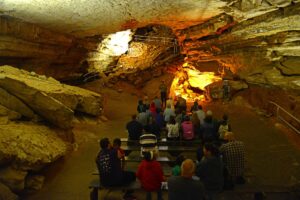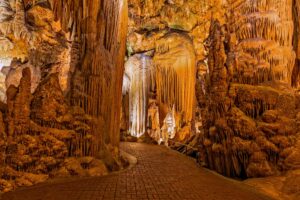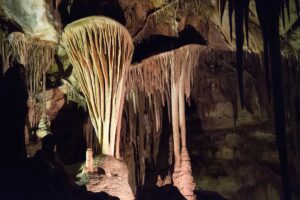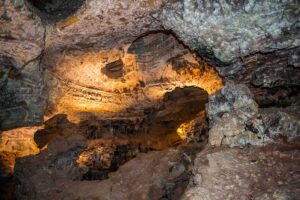
Mammoth Cave is like a living museum of geological history. (Image by rukawajungm Shutterstock)
If you’ve ever taken a cave tour, you know how fascinating exploring below the Earth’s surface can be. If you’re new to cave exploration there are a lot of cave systems to experience. In the U.S. alone, there are 150 caves open to the public. And you can find a cave system to visit in nearly every major region of the country.
In many cave systems, you can see icicle-like rock formations hanging from the cave’s roof (called stalactites), along with unique stacked mineral formations on the cave floor (called stalagmites). Other cave systems have flowstone formations that look like frozen waterfalls atop of rocks. And some caves have rare geological features — like boxwork formations — that look like a group of square and honeycomb-like patterns made of thin lines crisscrossing each other.

Boxwork formations at Wind Cave (Image by Roadwardbound, Shutterstock)
Cave tour managers also offer varying levels of difficulty, so you can find the level right for you. For beginners, taking a guided tour in a well-developed cave like Mammoth Cave National Park in Kentucky gives you a safe introduction to cave exploration. It’s also a great place to see stalactites and stalagmites while you’re walking an underground path.
If you’re an intermediate caver, you may want to explore caves with more challenging terrain where you crawl through narrow passages and climb over rock formations. Lehman Caves in Nevada is a popular cave for intermediate cave tours.
For more advanced cavers, some ranger-led tours in places like Wind Cave National Park in South Dakota, you can explore lesser-known sections of the cave — potentially involving crawling through tight spaces and navigating more challenging terrain.
Here are the top four recommended caves to explore in the U.S.:

Mammoth Cave National Park (Image by Wangkun Jia, Shutterstock)
Mammoth Cave National Park, Kentucky
Mammoth Cave National Park in Kentucky is a sprawling underground network that stands as a testament to the geological forces that shaped the region. This mammoth cave system — the longest known in the world — has an extensive labyrinth of passages and chambers for you to explore.
Mammoth Cave is like a living museum of geological history, with stalactites, stalagmites and gypsum formations that took more than 1,000 years to form. Exploring the cave is like stepping back in time, offering a glimpse into the lives of early inhabitants and the era of underground saltpeter mining.
You can choose from more than 15 tours, including an Accessible Tour, a Great Onyx Lantern Tour and an Extended Historic Tour. And if you’re more adventurous, Mammoth Cave also provides opportunities for you to experience challenging ranger-led cave tours like a crawling tour known as the Wild Cave Tour typically offered through mid-October. On the Wild Cave Tour you spend a full day climbing, crawling and maneuvering physical obstacles.

Luray Caverns (Image by jgorzynik, Shutterstock)
Luray Caverns, Virginia
Luray Caverns in Virginia is a subterranean wonderland where you can see first-hand the artistry of nature. This U.S. Natural Landmark sits beneath Virginia’s Blue Ridge Mountains and is the most visited cave in the U.S. Explorers discovered the cave in 1878 and it is known for its cascades, columns, stalactites, stalagmites and pools.
Here are three highlights of Luray Caverns:
- The Great Stalacpipe Organ: Luray Caverns is home to a unique musical experience — the Great Stalacpipe Organ. This instrument is the largest of its kind and transforms the cave’s natural formations into a symphony. The organ doesn’t use regular keys like a piano. Instead, it turns the cave’s pointy rock formations into musical notes. When you hear it, it’s like the cave itself is playing a tune.
- Dream Lake Reflections: Another of the standout feature of Luray Caverns is Dream Lake, a crystal-clear subterranean lake where you can see reflections of the surrounding formations. This is a great vantage point for photographers.
- Cathedral-sized Chambers: Luray Caverns also has expansive chambers that rival the grandeur of cathedrals. These spaces, adorned with towering formations, will leave you with a feeling of awe and wonder.

The Parachute Shield in Lehman Caves (Image by William Cushman, Shutterstock)
Lehman Caves, Nevada, in Great Basin National Park
According to the National Park Service, Lehman Caves is the longest cave system in the state of Nevada, and tour guides have been guiding visitors through the cave for more than 167 years.
You can only tour Lehman Caves on a ranger-guided tour. You can choose from two tours of the caves in the summer months: the Lodge Room tour and Grand Palace Tour. In the winter months, the Lodge Room Tour is offered.
Lehman Caves is renowned for its unique formations, including the Parachute Shield, a rare (and delicate) shield-like formation that captivates those lucky enough to witness its fragile beauty. You can also see ancient fossils for a glimpse of prehistoric inhabitants of the region. During your tour rangers provide in-depth insights to the cave’s geological features.
This cave tour is also very popular, so tours may sell out quickly, often weeks in advance.

Wind Cave (Image by Cheri Alguire, Shutterstock)
Wind Cave National Park, South Dakota
When you explore Wind Cave, you walk through a series of tunnels. So far, scientists have surveyed more than 140 miles of tunnels, but not all of those are open to the public. One of the most fascinating things about Wind Cave are the formations called boxwork. You can see these delicate structures that resemble a honeycomb or spider webs throughout the cave. Up close you can see the crystals on these formations that look like frosted flakes. These formations are crystalized fins left behind when limestone dissolved. And they’re rare.
You’ll also experience something known as the Natural Barometric Phenomenon. It’s a “breathing” phenomenon where air flows in and out of the cave entrance due to the atmospheric pressure changes.
There are six guided tours, with two of those tours only running in the summer. The tours also have varying difficulty levels. For example, you can choose from an Accessibility tour that lasts 30 minutes and is fairly easy or a summer Candlelight Tour that’s challenging and takes two hours with a total of 424 stairs, during which you’ll be required to bend and stoop while exploring less-developed areas of the cave carrying a candle bucket.
If you’re an advanced-level caver looking for the ultimate challenge at Wind Cave, the Wild Cave tour takes four hours and is described as “Very Strenuous.” The passages are not lit, and trail surfaces are uneven, wet and slippery. Some of the cave ceilings are low and some passages have a very steep grade so you’ll be required to bend, stoop, crawl and climb with most of the tour spent crawling on your hands and knees.
Suzanne Downing is an outdoor writer and photographer in Montana with an environmental science journalism background. Her work can be found in Outdoors Unlimited, Bugle Magazine, Missoulian, Byline Magazine, Communique, MTPR online, UM Native News, National Wildlife Federation campaigns and more.
 Your Privacy Choices
Your Privacy Choices
 The
The